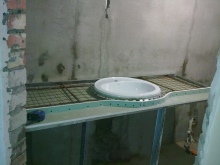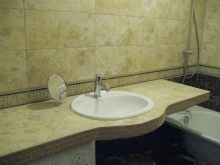Washing machine under the countertop in the bathroom
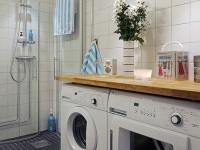
Washing machines have become a familiar phenomenon in our apartments for quite some time, but the problem of their placement to this day remains relevant. Owners of private houses or free-standing apartments can equip their homes with a laundry room and comfortably place there all the accessories for washing, ironing and drying laundry. Those who live in standard city apartments, have to go to various tricks in search of places to install the washing machine.
Most often these places are the bathroom or kitchen. And the kitchen area - this is not the most suitable place for a washing machine, as all the pleasure of eating with the family will be violated by noise, hum and vibrations produced by the device. Bathroom for the installation of the "washing machine" is most suitable, as in this room we do not spend so much time, and the sounds of the washing machine will not disturb us.
However, most bathroom can not boast a large area, and to find an extra square meter for a washing machine is not easy. That is why designers and constructors are constantly in search of new solutions. Today, the washing machine can be installed under the sink or built into a cabinet. One of the most interesting solutions is to install the unit under the countertop.
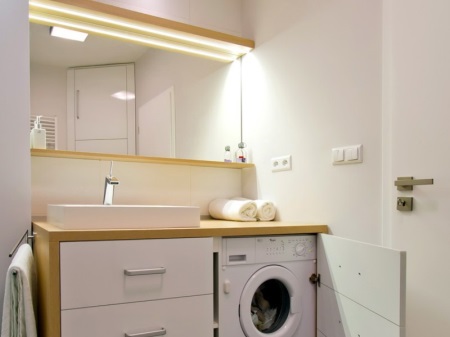
Requirements
- To the place of installation of the washing machine must be connected all necessary communications, namely electricity (the presence of moisture-proof socket is a prerequisite), water pipes and sewage outlet.
- The height of the countertop must be a few centimeters more than the height of the washing machine. This condition must be respected for ease of installation, repair and for the normal operation of the unit.
- Particular attention should be paid to the choice of material from which the countertop is made. The ideal solution is natural or artificial stone. The material must be resistant to moisture, temperature fluctuations and mechanical impact.
- Not every washing machine will be suitable for installation under the countertop. The device must be narrow enough, otherwise it will protrude from behind the countertop, which does not look very aesthetically pleasing. In addition, only front-loading washing machines are suitable for this method of installation.
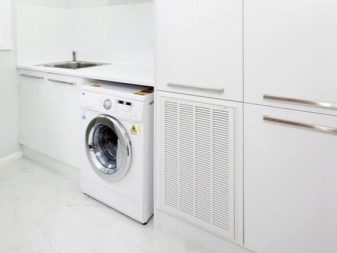
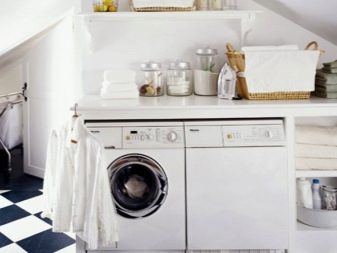
Advantages
- The countertop makes it possible to use the space above the washing machine with advantage. It can be occupied by cosmetics, shampoos and towels. And if the storage space for toiletries is already provided, on the countertop you can put a vase with flowers, an original lamp, candles and any other decorative elements.
- Tabletop serves as a reliable protection for the washing machine against mechanical damage and other impacts. Heavy objects placed on the "washing machine" can damage the work of the unit, but the table top will easily withstand the load. In addition, the countertop will protect the appliance from spilled water or detergent.
- Finally, a long countertop allows you to design the entire room in a single style. A beautiful countertop will serve as a unifying element for all elements of the bathroom interior, including plumbing, appliances and furniture.
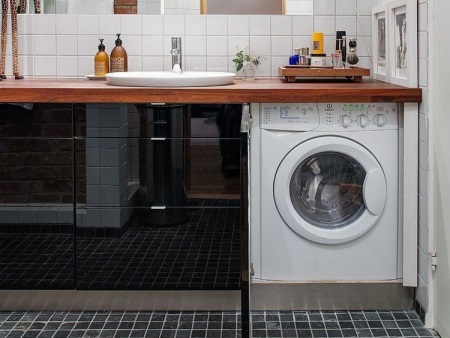
Cons
- The countertop and the washing machine must be chosen taking into account the features of each other. You should consider not only the dimensions, but also the technical features (e.g., type of loading) of the washing machine. Therefore, look out for washing machine models designed for built-ins. In addition, furniture and appliances should match in style and color.
- If you buy a countertop made of natural or artificial stone - it will cost you quite a bit. And other options, although they will cost much cheaper, look not so effective. However, you can build a beautiful and durable countertop with your own hands. About how to do this, read a little below.
Types
Depending on the method of installation, you can distinguish the following types of countertops for the bathroom:
- suspended - mounted on the wall with brackets;
- floor - mounted on the floor with the help of supporting legs.
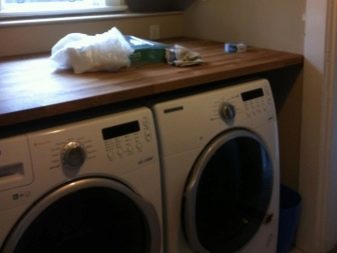
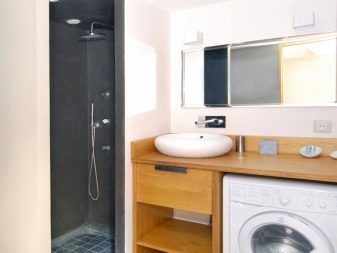
Also bathroom countertops differ in the type of construction:
- One-piece models are countertops, joined with the sink as a single unit. They are made, as a rule, of marble of natural or artificial origin. One-piece countertops are not only very beautiful, but also convenient to use. The disadvantage of such models are considered large size and high price.
- Equipped with built-in sink countertops are very practical and functional. The main advantage of such models is the modularity, as in addition to the sink, the countertop can be equipped with drawers for storing hygiene products.
- The countertops equipped with an overhead washbasin look really spectacular. The sink placed on the countertop looks like an antique vase for washing or like a flower petal. In this case, usually order washbasins made of stone or glass.
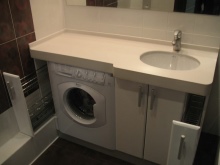
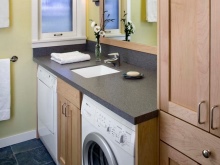
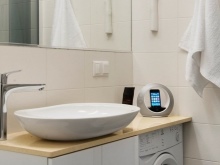
Features of installation
There are several rules that can not be ignored when installing the washing machine under the countertop in the bathroom.
- It is very important to take correct measurements. It is better to measure the washing machine and the countertop several times, so that in the process of installation you do not have to redo everything urgently.
- When installing the washing machine, use a construction level. Adjustable legs will help to give the "washing machine" the optimal position. To avoid strong vibrations and, as a consequence, possible damage to the table top, special rubber pads on the legs of the washing machine will help.
- Pay special attention to the connection of the machine to the water pipes and sewer outlet. If the machine is installed under the sink, you will need a special siphon.
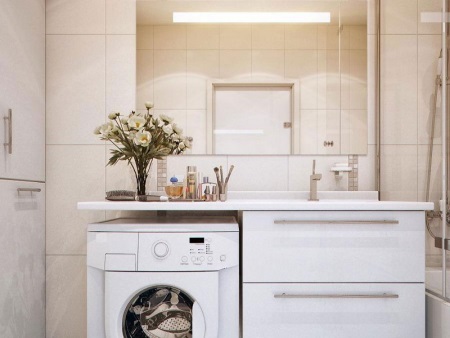
Drywall countertop with their own hands
- As in most cases, the work begins with measurements. Armed with a construction meter and a pencil, determine the dimensions of the future countertop.
- On the basis of the measurements we assemble the frame of the tabletop. A special metal profile for plasterboard is best suited for this purpose.
- Then we cut the components of the future construction from gypsum board. In this case, in the upper part of the countertop, it is necessary to cut a hole for the sink. Another similar shape should be cut out of plywood.
- Mount two brackets to the wall, which will hold the structure.
- On the brackets, first we fix the form of plywood, then - plasterboard with a cutout for the sink. At the bottom, a one-piece drywall form is attached.
- Now it is necessary to make the end part of the countertop from a strip of plasterboard. To make the end part smoothly curved, along the entire length of the drywall, make incisions every 10 mm.
- The assembled construction should be primed and putty. To ensure that the countertop was not afraid of water and steam, treat it with a sealing composition.
- One of the best options for finishing such a countertop will be a ceramic mosaic. The elements of the mosaic are attached to a special adhesive, and the seams between them are filled with moisture-resistant grout.
